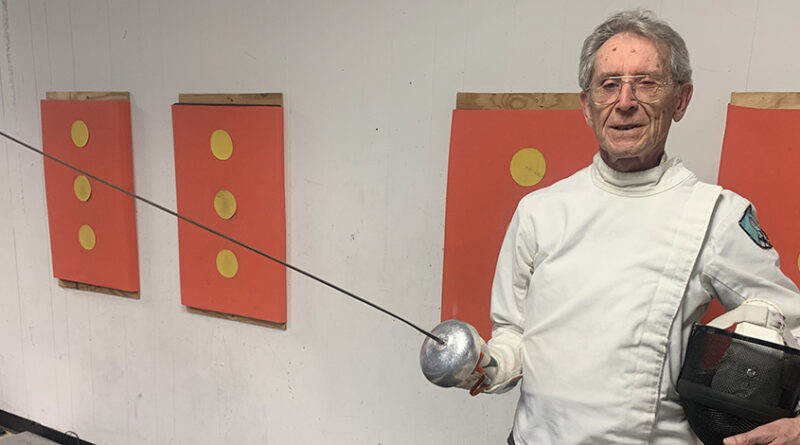Fencing, Fishing Keep Fayetteville Man Young
By David Figura
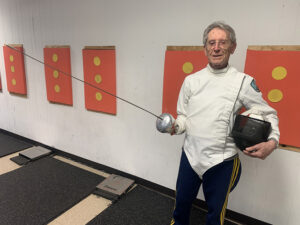
It’s a Tuesday evening and about a half-dozen teenage students are getting ready for a fencing lesson at the Syracuse Musketeers Fencing Center, located above a tattoo shop in East Syracuse.
In walks Les Monostory, who is there to help out with the students.
He’s proudly wearing a jacket and fencing pants he wore during the 1978 Empire State Games when he won a WNY regional gold medal in foil fencing. “And yes, these pants still fit,” the 81-year-old, Fayetteville resident said.
Monostory’s formula for keeping active, happy and relevant is two-fold: He enjoys working out and teaching the sport of fencing. He also loves the outdoors — particularly fishing and being involved in water quality issues.
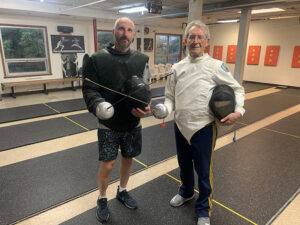
His fencing resume includes championships and honors while fencing on Syracuse University men’s varsity squad, a team he later coached for two seasons.
Today, he shows up one or two times a week at the Syracuse Musketeers Fencing Center. There, he assists Lubo Kalpaktchiev, the school’s master fencing instructor, with his students.
Meanwhile, Monostory handles a fishing rod with the same enthusiasm as a foil, epee or saber (the three types of weapons used in the sport of fencing). Among his memorable catches was a 54-inch muskellunge that he landed on the St. Lawrence River.
Monostory’s passion for the outdoors is bolstered by the fact that he holds a master’s degree from Michigan State University in water resources management. He worked for 32 years as an environmental planner for the Onondaga County Health Department and Environmental Management Council — a job that included doing research and assisting in other ways in the cleanup of Onondaga Lake and the Oswego River.
In 2010, Monostory was one of six national finalists for Field and Stream magazine’s Heroes of Conservation award. The magazine highlighted his accomplishments — particularly his efforts as the founder of Central New York Chapter of the Izaak Walton League of America, one of America’s oldest and successful conservation groups. He continues to be involved to this day as president of the state organization.
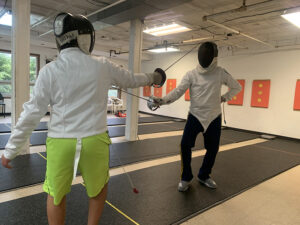 The magazine also noted he helped start Project Watershed, an outreach program that recruits high school and elementary school students to clean up and monitor local lakes and streams.
The magazine also noted he helped start Project Watershed, an outreach program that recruits high school and elementary school students to clean up and monitor local lakes and streams.
“I enjoy working with young people — both at the fishing and fencing end,” he said.
It’s quite a list of accomplishments for an individual who arrived in this country at the age of 9 after his family emigrated to Cleveland from Hungary in Eastern Europe.
He traces his love of fishing and outdoors to the fact his family took week-long vacations during his childhood at a cottage on Chautauqua Lake in Western New York. During those vacations, there was a neighbor who each summer generously allowed Monostory and his siblings to use his fishing gear and later a small rowboat to get out on the water.
Monostory’s passion for fencing began at age 16, when a relative of a family friend, who was also Hungarian, began giving him fencing lessons in the basement of his house.
In order to find some competition, the teenage boy began fencing with students at nearby Fenn College (today, Cleveland State). He received additional instruction and encouragement from the college’s varsity fencing coach, who was also Hungarian.

In 1961, Monostory was accepted to the then-SUNY College of Forestry in 1961 on the Syracuse University campus. While pursuing a four-year degree in zoology, he joined the SU men’s varsity foil fencing team.
On the varsity squad from 1961-65, Monostory was a two-time North Atlantic Foil Team Champion with teammate Harvey Schuman during his sophomore and junior years. He also received the Dean Dellis Award for the best fencing team record in 1964.
His fencing coach during those years was Alex Dako, a fellow Hungarian and also, like Monostory, an enthusiastic fisherman.
“He was like a stepfather to me. We traveled all over the place together to fish. Places like Lake Ontario. Oneida Lake, Seneca Lake,” he said.
Monostory went on to graduate school at Michigan State University, where his master’s thesis was a management plan for the Chautauqua Lake watershed. While there, he was also the school’s assistant fencing coach.
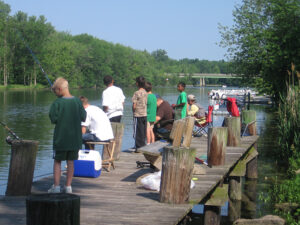
Returning to SUNY ESF in 1969, he became the school’s first doctoral candidate in a water resources program. He also became SU’s third and last men’s varsity fencing coach during the 1971 and 1972 seasons.
Fencing became a club sport at SU in 1973 and remains a club sport to this day with participants working out at the old Archibald Gymnasium under the instruction of Kalpaktchiev, who is an adjunct professor.
After coaching the college’s fencing club for a couple of years, Monostory formed the Onondaga Fencers Club in 1976 at Onondaga Community College with fellow fencer and R.I.T graduate Chris Cummings. The club hosted the first fencing competition at the Empire State Games in 1978.
Monostory continued to coach young fencers and compete in epee and saber contests — at times against fencers half his age. During his early 60s, the right-handed Monostory suffered a shoulder injury during a competition and learned how to fence left-handed while he healed.

Competing at the masters level, between 2004 to 2006, Monostory won three gold medals in epee fencing and two silver medals in saber fencing at the Empire State Games and the NYS Fencing championships.
“Over the years, I’ve had the opportunity to compete against and learn from national and Olympic champions,” he said.
He was inducted into SUNY ESF’s Athletics Hall of Fame in 2020.
“One thing I’m particularly proud of is that during my time with the Onondaga Fencers Club and the Syracuse Musketeers, we managed to help about a half dozen of our top, young fencers get scholarships at colleges across the Northeast,” he said.
Asked about his love of fishing, Monostory replied: “For me, it’s just getting out on the water, the challenge and the opportunity to keep participating in a sport that I love.”
Fencing 101
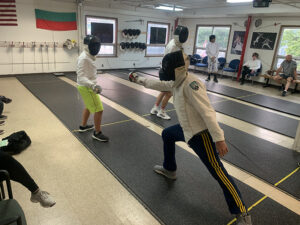
Fencing competitions for men have been part of every summer Olympics since the 1896 Athens Games. Women’s fencing made its debut on the Olympic stage at the 1924 Paris Games.
Participants face off on a 40-foot-long by four-foot wide strip, armed with one of three types of weapons, depending on the competition. The three weapons are a foil, epee or a saber. Their tips are blunted (and in the case of sabers, edges dulled) to reduce injuries.
Competitors’ outfits and weapons are wired so that when one fencer touches or slashes the opponent’s body with his or her weapon a circuit is completed and a light goes on the scoreboard. Points are received during timed matches by making a touching or slashing on the targeted area of an opponent’s body, which varies depending on the weapons used.
“In Hungarian, boxing is called hand fencing; you have to use your skills against someone else’s skills. The more you compete, the greater your skill set becomes,” Les Monostory said.
Some fencers compete in all three events using the three different types of weapons, but most chose to concentrate their skills using only one kind.
The following are brief descriptions of the weapons used in competitions, according to usafencing.com:
*The foil: “The foil is a descendant of the light court sword formally used by nobility to train for duels. The foil has a flexible rectangular blade, approximately 35 inches in length and weighs less than one pound. Points are scored with the tip of the blade and must land within the torso of the body. The valid target area in foil is the torso from the shoulders to the groin in the front and to the waist in the back. It does not include the arms, neck, head and legs. This concept of on-target and off-target evolved from the theory of 18th-century fencing masters who instructed their pupils to only attack the vital areas of the body, i.e. the torso. Of course, the head is also a vital area of the body, but attacks to the face were considered unsporting and therefore discouraged.”
*Epee – “The epee (pronounced “EPP-pay,” meaning sword in French), the descendant of the dueling sword, is similar in length to the foil, but is heavier, weighing approximately 27 ounces, with a larger guard (to protect the hand from a valid hit) and a much stiffer blade. Touches are scored only with the point of the blade, and the entire body, head to toe, is the valid target area, imitating an actual duel. “
*Saber – “The saber is the modern version of the slashing cavalry sword, and is similar in length and weight to the foil. The major difference is the use of the blade. The saber is a cutting weapon as well as a thrusting weapon; therefore, competitors can score with the edge of their blade as well as their point. The target area is from the bend of the hips (both front and back), to the top of the head. This simulates the cavalry rider on a horse. The saber fencers’ uniform includes a metallic jacket (lamé), which fully covers the target area to register a valid touch on the scoring machine. Because the head is valid target area, the fencer’s mask is also electrically wired.”
For more, see usafencing.com.

